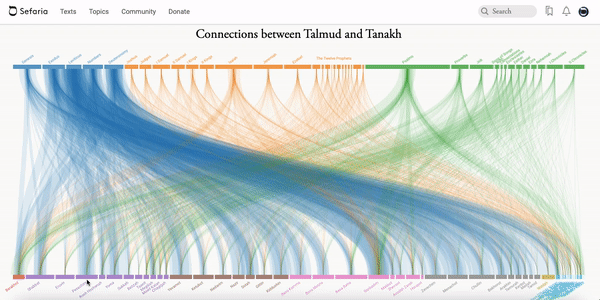How do the texts relate to each other? How are they in conversation with each other? Sefaria's visualizations provide a unique look at the relationship between texts.
The Link Explorer allows students to see the relationship between various texts in an unexpected way.
Example: Talmud and Tanakh
- Choose a masechet (tractate) of Talmud, such as Pesachim or Megillah.
- Ask the students which books of the Tanakh they think will be quoted the most in the masechet.
- Open the Link Explorer and click on the masechet at the bottom to see the connections. Suggested questions to ask the students:
- Were you surprised with the results?
- Besides the expected connections, were there others?
- How did the unexpected connections relate (or not) to the theme of the masechet?

Links Through Rashi shows links between verses of Torah that are connected by virtue of Rashi quoting one verse while commenting on another.
- Hover over the grey ring to reveal connections.
- A black title reference represents the selected verse.
- A green title reference means that the Rashi on that verse quotes the selected verse.
- A red title reference is quoted by the Rashi on the selected verse.
- Click a verse to open it with Rashi's commentary.
Suggested questions and activities to use with the visualization:
- What is your impression of Rashi's breadth of knowledge from looking at the visualization?
- Hover over the grey ring and click on a connection with a green title reference which opens the text. How does Rashi connect the two verses?

The line indicates that Rashi's comment on Exodus 23:10 quotes Deuteronomy 22:2.
Click to open Exodus 23:10 and Rashi's comment on the verse in the library. You can see how Rashi incorporates Deuteronomy 22:2 into his comment.





